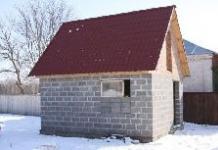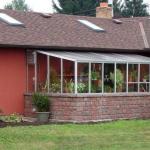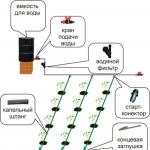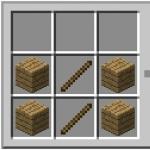Smooth garden paths will decorate any personal plot, but in order to extend the durability of the coating, it is necessary to choose the laying material based on the expected traffic and load on the path, and organize its reliable paving. The installation process itself paving slabs simple. The advantage of curly paving elements is the possibility of dismantling the material with subsequent laying, and the finished path requires minimal maintenance. Let's look at the main points that are worth knowing in order for backyard paving to be successful.
Choosing paving slabs
The material that will pave garden paths is clay, stone, and even treated wood, but most paving slabs are made from concrete. geometric shape, patterns and sizes of tiles (from 10x10 to 50x50 cm) are varied.
Remember that if garden paths will be subject to intensive use, then small-block material fit better, although it will take more time to lay it. It is better to place a path from such paving slabs centrally, for example, a path from the gate to the house.
| paving slab type | Appearance | Service life, years |
| Vibro-pressed | simple shape and color | 15-20 |
| cast | Diverse shape, shiny and smooth surface, pattern is possible | 10-15 |
Vibropressed tiles are suitable not only for garden paths, but even under a parking place or car exit, because. this material is considered more durable and frost-resistant.
Ceramic pavers are more attractive than concrete blocks and retain a rich shade longer. The ceramic coating does not need special care.
Useful tips for choosing paving slabs:
- The brightness of the material indicates a significant proportion of dyes in the composition of the tile, due to which its quality decreases: garden paths will be cracked, and the tile will begin to crumble.
- Before buying a tile in a store, check its quality by tapping one tile against another. If the sound is sonorous, you have a product in front of you High Quality. If the sound is deaf, then the drying of the tile was not carried out in accordance with the technology, and the material is of dubious durability.
- The material should be without bright white or black stripes and with a uniform color.
- The minimum frost resistance value (number of freeze-thaw cycles) should be 150.
- The thickness of paving slabs directly depends on the expected mechanical load, namely:
- 4 cm - pedestrian traffic;
- 4-6 cm - people on bicycles or with wheelbarrows;
- 6-8 cm - near the entrance or parking of the car;
- 10 cm - movement trucks, but for personal plot tiles of this thickness are rarely used.
If a truck with wood or bricks drives into your site a couple of times a year, then it is enough to make garden paths from material 6-8 cm thick.
Preparing a site for laying tiles
Quality preparatory work affects the durability of the paving, reduces the risk of tile sagging and prevents large-sized material from spreading.
"Dry" method
- Evenly delete upper layer soil 30-40 cm thick. If the soil is clayey, then it is necessary to cover it with young slag of 5 cm or lay on top of needle-punched geotextile with a density of 300 g / sq.m. If there is sand on the site, then it does not need additional preparation, since it is quite resistant.
- Backfill the ditches in layers gravel or crushed stone, tamping the base every 15 cm, which will reduce the volume of procurement material by 20%. It is better to acquire a different fraction size and mix it during falling asleep - this will provide better adhesion of the material and increase the density of the preparatory layer.
- Do backfilling with sand with a fraction of 1-4 mm, layer thickness - 3-5 cm. Some recommend making a substrate from cement-sand mortar, but this can cause difficulties during dismantling and subsequent laying of tiles. We recommend using this mortar in a place where water will penetrate into the garden paths, for example, near rainfall trays. To save beneficial features bedding, it is not recommended to walk on it.
- For an unobstructed stack of precipitation from paving slabs, we recommend laying the bedding with cross slope up to 3% from the center of the paving to the edges. In situations where this cannot be done for a number of reasons, a two percent bias in one direction is allowed.
- Recommended the slope of the infield is 10%, on a long area it is up to 14%. But if the cottage is located in the area with difficult relief, we advise you to secure the movement of people and install a stepped path.
"Wet" base for garden paths
There is also a "wet" method of preparing the base for paving slabs, which will require more costs time and material. The peculiarity of performing a screed on a cement mortar is to limit the area to 0.5 sq.m, so the path should be poured in sections. It is possible to transgress to the next only after the complete hardening of the previous one.
Composition of the solution: mix M150 cement (1 part) with sand (3 parts) and water (1 part). The thickness of the solution is 2-3 cm, after which it must be compacted and cover all the cracks with a dry mixture of the solution. At the end of the "wet" method, the path is cleaned and it is ready for laying paving slabs.
Paving slabs
To lay the track you will need the following tools:
- tape measure with a level or theodolite;
- shovel and wheelbarrow;
- tamping machine with a vibrating plate, in which the working weight is from 90 kg;
- rubber mallet or wooden hammer in the absence of the previous one;
- trowel;
- great;
- Bulgarian.
Lay the first row of paving slabs on the prepared surface so that the level protrudes by 1 cm of the planned one (reserve for shrinkage during tamping). In order for the garden paths to have a uniform color, we advise you to take the paving stones alternately from two different pallets.
The gap on the tile joint for ordinary walking paths equal to 2-3 cm, for a place for exiting or parking a car, a distance of 3-5 cm should be left between the tiles. The quality of the seams can be checked after paving in 3 rows, and the presence of depressions or bumps in the surface is checked every 6 rows.
Grouting is done by pouring sifted dry sand with a fine fraction and rubbing it into the tile with a brush or broom. Sweep away excess sand with a broom.
There are two ways to tamp the surface of the track on a personal plot: using a rammer and a vibrating plate or rubber mallet. Compaction should be done in 2-3 passes, each time pouring clean sand onto the surface, thereby densely filling all the gaps between the tiles. In the first month of operation of the track, it is also necessary to apply clean sand several times and sweep it away after a couple of days.
Curb device
Curb blocks - the final link in the paving. They have two functions: they separate garden paths from lawns and flower beds, preventing the destruction of paths. The evenness of the curbs is important, so they must be set according to the level.
Modern products that serve as boundaries for paths are made from a mixture of concrete and plasticizers by vibrocompression, so they are resistant to natural factors and durable. In addition, dyes are added to the blocks, thanks to which you diversify the landscape in your backyard.
To pave the curb, dig a trench a third of the height of the product and 5 cm wide more than the curb stone. The stock is useful when pouring the solution. Thoroughly compact the soil in the trench and pour a mixture of sand and cement (1: 3).
Place the blocks in the center of the trench to leave space on both sides for pouring the mortar, and also leave a gap between the curbs of 0.5 cm. Having paved all the elements of the fence, you can start preparing the cement-sand mortar (the proportion is similar, but plus 1 part of the water ). The mixture is aged for a day, after which proceed to the preparatory work for installing the tiles.
To make garden paths original, make blocks for the curb yourself. Knock down formwork from fiberboard or plywood sheets by connecting the parts with screw clamps. An alternative is to purchase ready-made forms.
For cooking concrete mortar mix 1 part sand, 1 part cement, 2 parts small fraction gravel. The form must be lubricated with ordinary sunflower oil, pour the mortar and wait until the concrete mixture is almost dry. The mass should not completely harden, because. when removing the formwork, the shape of the curb can easily be deformed. After a few days, the products will be completely ready.
Features of care
Paths on a personal plot need regular care, thanks to which you will maintain the coating in good condition and extend its service life. Some simple rules will help you with this:
- wash paving slabs with soapy water and a brush, and remove stains from machine oils with special solutions;
- break through the grass in time, which has grown in the gaps between the tiles, with a scraper;
- ice should be carefully removed with a plastic shovel, sprinkling the paths with sand, but not with salt, because it will damage the paving stones over time.
And do not forget about the planned repair of the track and immediately pay attention to the tiles that have sagged or lost their strength. Individual elements it is enough to dismantle with a screwdriver, make new layer backfill and renew the surface by ramming the garden paths with a rubber mallet.
garden paths, in the creation of which each owner suburban area investing a lot of time and money, will be short-lived and unfinished without a border. garden border necessary to protect the paths from pollution, to prevent their spreading and overgrowing with grass, to prevent soil erosion and maintain the given path geometry. In addition, the border often performs a purely decorative function, and sometimes the fences of garden paths are made the same, maintaining the overall style of the site. A border for garden paths can be made using ready-made purchased materials, or it can be created from improvised items. There are plenty to choose from.
No. 1. plastic border
The plastic border can be called one-stop solution for any site, since it can be both completely discreet and inconspicuous, and decorative. Main advantages plastic border for:
Flaw only one is synthetic material, but there will be no harm to humans and grown plants. In terms of strength and durability, plastic, of course, is inferior to stone.
The plastic borders featured on this moment in building stores, can be divided into such kinds:
- solid flexible roll tape, most of which will be in the ground. Such a border will be almost invisible, which means it can become a frame for a path on a site made in any style. It copes with its direct tasks: it does not allow the path to spread and prevents germination lawn grass. With such a ribbon, you can frame the paths of the most winding forms, but the border will not perform a decorative function;

- section borders. Each section has special elements that facilitate installation. Of these, you can eventually assemble a nice decorative border;

- finished fencing of a certain shape can imitate tiles or other materials.

Installation of plastic curbs is a simple process and usually involves the use of special anchor pins. Latest for different types soils should be different: wooden ones are suitable for soft soil, metal ones are suitable for stony soil. It is better not to use a plastic border for framing stone paths.
No. 2. concrete curb
In most areas, garden paths are framed with a concrete curb. He owes such popularity to the strength characteristics and relative cheapness, as well as the possibility of making it yourself. The concrete curb will great option for framing, stone, pavers and asphalt.
Main advantages:

Among shortcomings big weight and a meager selection of ready-made curbs, as well as relatively time-consuming work on preparing the ground for the installation of such a curb. are sold in several sizes, they can be stacked on the edge or on the wide side. If the dimensions, shape or appearance of the finished concrete blocks are not to your liking, you can make your own border using ready-made or. You will need to prepare the solution and pour it into the blanks, and after waiting for complete hardening, use the resulting product for its intended purpose. can be dyed in the mass in the desired color or decorated with pebbles, shells, small stones, glass, prints to give a boring material a unique look. 
A concrete curb, bought or made by hand, is heavy, so preparatory work due attention should be paid - the durability of the structure depends on them. You will need to dig a trench about 20 cm deep, fill it up, tamp it down and fill it up. The latter is poured with water and also carefully tamped, after which it is poured cement mortar, into which the elements of the border are immersed. Using a rubber mallet, they are aligned to required level, the remains can be poured into the joints. A concrete curb can also be installed in parallel with the creation of a garden path. 
Another option for arranging a concrete curb - pouring concrete with formwork. The process resembles the preparation of a tape, saves time, but the curb obtained in this way will have low decorative qualities. Work begins with digging a trench of the desired depth and width, then formwork is installed. A sanded board will do for its manufacture, but if you plan to create a path with bends, then it is better to use plastic, MDF or steel. The formwork is fixed with pegs, and then filled with cement mortar prepared in or independently using any suitable container. Now it remains to level the surface, and after the concrete has hardened, you can remove the formwork and cut expansion joints in increments of 100-150 cm to prevent cracking. While curing, the concrete can be decorated with pebbles, pieces or mosaics. Such curbs can be used for bulk, asphalt or paths made from improvised materials.
No. 3. metal border
One of the strongest and most durable borders is metal. It can be made from stainless steel, aluminum or copper, and be in the form of ribbons or rods. Ribbons, like a plastic counterpart, serve as an invisible fence of the track. They go deep into the ground by at least 10 cm, from above they can rise above the surface level by no more than 2 cm. Metal tapes retain the shape of the track, prevent grass from growing, while remaining invisible. fencing from metal rods more of a decorative function: forged elements, for example, may have common features with forged borders of the tracks, allowing you to perceive the site as something harmonious and made in one. 
Main advantages:
- high strength and durability;
- resistance to a wide range of temperatures;
- excellent preservation of the shape of the track;
- simple installation;
- the ability to use for the design of paths of a sinuous shape.
Among cons only the price, therefore, if necessary, to equip borders invisible to the eye, the choice often falls on plastic.
No. 4. wooden border
Wood can be used to build walkways in one of a variety of ways: boards, bars, pegs or saw cuts. Ready-made borders can be found in the store, they are easy to make on your own, and you can even use the remnants of lumber. Wood curbing is best for fencing wood paths or tree bark pavements. 
Main advantages:

A wooden curb will do an excellent job with its direct functions, but its the main disadvantage is low durability. The tree needs to be processed protective compounds before installation, and then regularly during the operation of the curb, but it is still unlikely to last more than 10 years. Installation will require minimum effort: make a trench, organize a drainage cushion and lay it.
It is worth noting separately wicker borders, which are made from a vine, but they play a predominantly decorative role, so it is better to combine them with a plastic or metal tape in order to maintain the shape of the track. 
No. 5. brick border
For arranging a border, you can use inexpensive sandstone, limestone or shell rock or more expensive marble or granite. In any case, the stone curb will beautiful design paths made of tiles, stone and even concrete. Among the shortcomings of this type curb great weight and high price
. To like stylish design garden paths became available to a wider circle of people, some manufacturers offer fake diamond designed specifically for arranging paths. 
Installing a stone curb is a simple and quick process. In addition to digging a pit, creating a drainage layer and ramming it, it is necessary to use agrofibre so that grass does not subsequently grow through the stones. The stones are set close to each other, and a finer fraction can be used in the gaps.
No. 7. "Green" border
The border of the path can be decorated with plants. It will look very nice, but when deciding on such an option, it is worth remembering that great efforts will need to be made both at the stage of creating the border and in the process of maintaining it in order to maintain proper appearance. "Green" border can serve decorating stone or gravel paths. It is planted according to the same principle as hedge, but plants are better to pick up a small height.
Plants such as boxwood and cotoneaster are usually used, lavender, bergenia, sage, cloves and some others are also suitable. The height of such a border should not be more than 30 cm, and the width should be around 25-30 cm. Care for the "live" border should be constant, like all plants in the garden. It will have to be regularly watered, fertilized and trimmed.  - there are a lot of options, but the main thing is not to forget that the curb must cope with its main functions and be more or less durable.
- there are a lot of options, but the main thing is not to forget that the curb must cope with its main functions and be more or less durable.
It is better to decide what the curbs for garden paths on the site will be made of, even before the construction of the paths themselves, at the planning stage. Some types of curb will be much easier to install in parallel with the arrangement of the track itself.
Design of a personal plot in country house it is impossible to imagine without beautifully designed tracks. Garden paths not only perform a functional role, visually delimiting zones (lawns for games, flower beds, ornamental plantings, etc.), but also serve as a decor element themselves. To increase the service life of the coating and to accentuate the tracks, curbs are used, which can be presented from various materials. The type of curb is determined overall design garden and the shape of the paths. Some curbs can protrude significantly, while others are barely noticeable. In any case, their presence is mandatory. The article will focus on curbs for garden paths.
Types and features of curbs for tracks
For the design of garden paths, the following borders are used: plastic, metal, concrete and brick, wooden, wicker, stone, living plants. Each type has its own characteristics and difficulties in application. To stop the choice on a specific material, you need to focus on the style of the tracks ( a natural stone, paving slabs, cement coating, gravel, wood flooring) and the proposed laying technique.

- plastic borders the most versatile, harmonize well with different styles. Big choice color design allows you to create original design. They are indispensable when edging curved paths with flexible smooth lines. The advantages of plastic are high durability and resistance to corrosion, as well as the relatively affordable cost of the material. For self-assembly plastic borders are best suited, as they are very easy to install.
- metal borders made of stainless steel or, as a more expensive option, of copper and aluminum. Suitable for making smooth paths with straight turns. They go well with their gravel paths.
- concrete curbs look good only with straight tracks. During installation, they require certain skills, and the process itself will take a little longer than in other cases.
- Brick borders quite common and easy to install. Used as a horizontal arrangement facing brick, and laying with an inclination (in the form of teeth). This type of edging can hardly be called practical and durable. In areas with heavy and frequent rainfall, brick quickly collapses and crumbles. However, this material is ideally combined with paving stones and looks especially advantageous in the design, made in the English style.
border photo

- wooden borders are considered the least durable. They require annual maintenance, which consists of priming and painting. Raw boards or old slats should not be used for this purpose. Such savings will quickly remind you of yourself. Average term the service life of wooden curbs does not exceed 10 years. However, this is the cheapest and easiest design option. Such borders are usually used in rustic style or if you want to create an accentuated simple design.
- Wicker borders are made of willow branches and perform rather a decorative function. They will not be able to become an obstacle to lawn grass or hold back the flow of rainwater. Such a romantic design is more suitable for flower beds or simple garden paths.
- A natural stone is a leader in design. It is both practical and decorative material. Only its price can repel many connoisseurs of natural naturalness. For the manufacture of curbs, shell rock (cheaper), sandstone, granite and marble are used. An alternative may be various artificial imitations under natural stone.

- Hedges will always be favorites landscape design. There is a list of special border bloomers or ornamental plants. These include perennial undersized and flowering bergenia, bellflower, eland, primrose, gaillardia, hellebore, hosta, knifofiya and many others. Creating live borders is quite interesting. It is important to take into account the color contrast and architectonics of plants.
Installation of plastic curbs for tracks
- Laying plastic curbs does not require significant preparatory work associated with digging a trench, concreting the base or spreading non-woven material.
- Start by determining the contours of the track and the desired curb height. The manufacturers provide outside element hole for mounting pegs or anchors. Such a mount securely fixes the curb and does not require special devices, except for a hammer for driving in metal stakes.

- Plastic easily joins and bends, repeating the most virtuoso bends. When the curbs are fixed, the tracks are laid. If gravel, paving slabs or stone are used, you can hide the border completely to create a contrasting line with greenery and flowers. In this case, the design will reliably perform its functions of protecting the coating.
Installation of concrete curbs
- Concrete curbs are designed for high load, therefore, their installation implies a strong fixation.
- First, a trench is dug along the contour of the path (its depth will depend on the level of penetration of concrete stones). Further, the trenches are poured with a solution (one part of cement and 3 parts of sand), leveled and the stones are immersed in it tightly to the edge of the path. The solution should not be too liquid, as the stone will float and it will be impossible to fix it.

- After installing several stones, you will need to return to the first and proceed with fixing with an additional layer of cement at several points. Ideally, the border should protrude 5 cm. After the mortar has hardened, the trench is covered with earth or sand from the outside. This design will last a long time, retaining its original appearance.
- For the border, you can use self-made stones, but it is better to purchase ready-made elements with a guarantee of quality compliance from the manufacturer.
Natural stone curbing
- This type of edging does not require a trench, but a thin layer of soil will need to be removed to lay down the nonwoven.
- Large stones are tightly laid directly on the "litter". big gaps between them are filled with smaller pebbles. Finally, all voids are covered with dry cement.

- At first glance, this work seems simple and uncomplicated. However, it requires certain skills and patience.
General rules for installing curbs
- In order for the track to retain its shape and aesthetic appearance for a long time, it is necessary to prevent blunders when installing curbs. So where do they start work, and what stages can be distinguished?
- When marking the contours of the track, stakes are driven in, along which a construction cord is pulled, it will indicate the upper border of the curb element. When installing each subsequent element of the curb, you should check it correct position by level.
- It is undesirable to clog gaps in structures with cement, as this can lead to expansion and violation of the integrity of the curb under the influence of water and frost. It is safer if water does not linger in small gaps.
Original do-it-yourself borders
- For self-casting of concrete curb elements, special polymer molds are purchased. The length of garden forms does not exceed 50 cm, which is very convenient for subsequent installation. Implemented on the market garden molds most different configurations and sizes. They are reusable if a 3% solution was used to wash them. of hydrochloric acid. mechanical cleaning from concrete residues in case of adhesion is not allowed.

- By purchasing molds for casting, you can significantly save on the arrangement of a personal plot, since finished border elements are much more expensive. However independent production It will take a lot of time and will require knowledge of the correct preparation of the solution.
- For concrete mix use cement high brand(preferably 500), while four parts of sand are taken for one part of cement. Water is added to the consistency of rustic sour cream. For uniform and fast mixing, it is better to use a concrete mixer. If you want to get a painted border, you can add a special dye to the solution. The result is a truly original design.
- When pouring the solution into molds, it is necessary to monitor the removal of air bubbles, which reduce the strength of the product. The casting site must be perfectly flat (checked by level) and free from foreign objects. After a few hours, the solution will harden and you can carefully release the molds for a new batch. A day after additional drying, the curbs are ready for laying.

- The clear contours of the paths should be combined with the design of flower beds and play areas. Forms for pouring allow you to come up with different color solutions, delimiting zones while maintaining style.
- The design and installation of borders needs a creative approach. Even inexpensive material and a simple design can look very attractive if everything is chosen and tastefully done. If time permits, all work can be done independently. Hiring specialists, host country house expands styling options and the flight of your fantasies, but this will require additional money.
There are many options for edging garden paths, all it takes is a little creativity to create a unique harmonious design fairy garden. Well-groomed clean paths without land from the site will please both the owner and anyone who decides to walk along them.
Let's start with 3 categories.
III - I category - trails. As the name implies, these paths are trodden by feet, compacted by the wheels of a wheelbarrow or car. The ground on the path is dense and, as a rule, sagging. Therefore, trails are often a place for collecting storm and melt water, that is, potential puddles. Plantain, horse sorrel and "thorns" grow here, the seeds of which are carried throughout the site.
In order to turn such a “traditional path” into a convenient path, it is first of all necessary to ensure the removal of stagnant water from it. To do this, align the contour of the track: the pits fall asleep, and the bumps are cut off. The path itself (if the parent soil is loamy) is covered with sand, that is, sand is brought in and driven into the ground. Sometimes crushed stone is brought in with sand.
The next step is planting the path with soil-retaining plants (for example, low clover) or arranging a mixborder. By the way, this is how the paths near the house of Maria Theresa in Versailles (France) are made - simply, but with taste.
II - I category - paths with a filling base. These are traditional paths on cultivated garden plots. During their construction, they dig a bed to a depth of 10 cm. The bottom and sides of it are covered with geotextiles with a density of 150 - 200 g / m2 as a barrier to roots herbaceous plants. The sides of the bed can also be additionally secured with a border tape. The entire bed (to the level of the soil) is covered with rubble (but not lime), pebbles or screenings.
As decorative elements on top, you can lay individual paving slabs, processed trimmings wooden beams, Flagstone Stones. These elements are buried in the backfill layer, and they should not rise above the path and above the soil. With another method of constructing such tracks decorative coating more or less tightly fitted to each other. In this case, the bed is deepened by 5 - 10 cm and arranged sand cushion.
decorative coating
decorative coating ( sidewalk paving stones, tile, flagstone) are usually laid above the soil level, and the edges are sometimes fixed with a curb, which is made of curb stone, flagstone cuts, paving slabs, garden boards and cobblestone. But usually they do without a curb, bringing the lawn close to the path, or break the mixborder. The seams between the elements of the coating are covered with sand (filling with sand - cement mixture V this case does not make sense) and sown with dwarf lawn grass.
If a “Swiss path” is being built (1 step - 1 stone), then a sand cushion is prepared under each of the stones, laying them at the level of the soil.
Walkways with a solid base
Usually they are built where a large load on them is provided. Such tracks are also called "capital". Let's take a closer look at their device.
When constructing such paths, they dig a bed about 15 cm deep.
In places where it drops, that is, where storm or melt water will accumulate, it is drained (otherwise the path in this place may break). Sand is poured into the bed, leveled, spilled and rammed. The height of this drainage layer should be about 5 cm. The sides of the bed are framed with a border tape, and if it is not there, then with old linoleum or roofing felt cut into tapes.
Usually such a foundation is made at ground level. If they want to raise the path significantly, then plywood strips or boards, respectively fixed, are used as formwork. The concrete base itself, in order to avoid rupture, is either reinforced or thermal seams are arranged after 1.5 - 2 m. The second solution is cheaper, but in the spring there is a danger that improvised concrete plates rise or fall relative to each other.
This will not happen with reinforcement concrete base. It is only necessary to remember that armored bed nets, chain-link mesh, bicycle frames and other similar rubbish, which “zealous” owners often “roll” into concrete, are completely unsuitable as reinforcement. It is necessary to reinforce with a bar 05 - 8 mm or road maps- meshes welded from a 05 mm rod with dimensions of 0.5x2 m and with cells of 10x10 or 15x15 cm. The reinforcement is laid on "chanterelle" stands, for which fragments of bricks or blocks are suitable. They are necessary so that after pouring the reinforcement is in the thickness of the concrete.
Concrete is laid in a bed, leveled and moderately rammed. If there is not enough concrete for the entire track, a crossbar made of boards is installed at the end of the pouring, so that the concrete breaks off with an even “cut”, without sagging.
When pouring a new batch of concrete, the crossbar is removed.
This is how the entire base is gradually made, and after the concrete has set, a decorative coating (paving stone, tile, natural stone) is laid on top (on the cement mortar) and, if necessary, a curb. Usually, in its final form, the track bed is 3-5 cm above the soil level, which provides protection from soil alluvium on it. Can be used as a border curbstone or cobblestone.
If a few years after the installation of paving slabs, a separate part of the space begins to deform, this indicates violations of the laying technology of this type of coating. However, you should not worry and hastily calculate losses, since such a problem can be solved on your own. Certainly, ideal option it would be to call would-be masters and force them to restore the coverage. But it’s not always possible to find the culprits, since the cost of paving slabs has already included the cost of laying them. Therefore, it is more expedient to eliminate the sagging area with your own hands.
REASONS FOR PAVING SLABS
Before eliminating any problem, it is very important to identify the causes of its occurrence and subsidence of paving slabs is no exception. Experienced experts note that there may be several reasons for the failure of tiles, as a rule, they lie in non-compliance with the laying technology, and may also be a consequence natural phenomena.
For example, tiles very often sag due to insufficient compaction of the base. This is especially pronounced if, before laying the tiles, earthworks were carried out on the site (sewerage device, etc.). After laying pipes in the ground, sometimes workers miss one very important point- soil compaction. And if this stage is omitted after a few years, the tile will certainly sag under negative impact natural phenomena. This is usually observed in early spring after thawing frozen soil, which, under the influence of excessive moisture, shrinks.
Another reason that can cause subsidence pavement, acts as an increase in the level ground water. This is largely due to the movement of layers of the earth in the process of planning the site. It can also be explained by a natural process of nature - a change in the direction of the flow of groundwater. As a result, in a site where groundwater has never been observed, it can suddenly appear and make changes to the existing design.
RESTORATION OF PROBLEM AREAS
 Work on the restoration of sagging tiles begins with the dismantling of the problem area. If during operation and due to subsidence of the base, the tile was deformed, you will also need to buy paving slabs individually in required quantity. Next, soil is selected on the sagging area (the soil should be removed to a depth of no more than 50 - 60 cm) and the base is covered with sand, the layer of which should be 2 - 3 cm. Thus, the sagging soil is restored. These works also require a dense compaction of the new foundation.
Work on the restoration of sagging tiles begins with the dismantling of the problem area. If during operation and due to subsidence of the base, the tile was deformed, you will also need to buy paving slabs individually in required quantity. Next, soil is selected on the sagging area (the soil should be removed to a depth of no more than 50 - 60 cm) and the base is covered with sand, the layer of which should be 2 - 3 cm. Thus, the sagging soil is restored. These works also require a dense compaction of the new foundation.
Since the base is being redone, it will not be superfluous to use crushed stone instead of earth. Unlike soil, crushed stone has high density, thanks to which it does not absorb moisture from the ground and excludes subsequent shrinkage of the base. As a result, all the moisture present in the soil and coming from outside will not accumulate in the base, but will flow down. It is also worth noting that crushed stone withstands temperature fluctuations very well, helping to maintain the integrity of the road surface.
If it is necessary to restore an oversized sagging area, a device will be required drainage system. To do this, you need to install drainage at the bottom of the trench, which will become great solution groundwater problems. Once all the work to strengthen the base is completed, you can start laying the tiles. And finally, I would like to note the following: despite the fact that the cost of paving slabs is quite affordable compared to other materials, work to restore a sagging coating can take precious time. Therefore, it is necessary to carefully monitor the work on the device of such a coating.


























